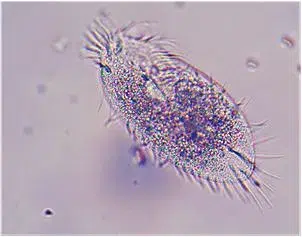Part 3 of Your Soil Microbiome: Protozoa

Healthy soils contain upwards of one million protozoa per teaspoon, but our ag fields commonly have numbers as low as one thousand. There are three main types of protozoa; ciliates, amoebae, and flagellates.
There are two types of amoebe: testate and naked. Testates are surrounded by chitin-based shell, while the naked amoeba have no shell. The naked amoeba are more mobile, which enables them to reach more areas in the soil and soil pores. This, in turn, increases their nutrient cycling capacity. In the soil, protozoa are the preferred food source for earthworms.
Protozoa are most commonly found in the top six inches of the soil because this is the major activity zone of the bacteria that comprise their main food. Like bacteria, they congregate around plant roots and they seek out soil moisture, which provides them maximum mobility in soil solution. During periods of drought, protozoa can form cysts that enable them to survive in a dormant state until the rains arrive.
Protozoa largely feed upon bacteria, algae and fungi and are hugely important in the regulation of both bacteria and algae, to maintain biological balance.. In the absence of protozoa, bacterial numbers explode and this can pose problems in terms of nitrogen cycling.
Bacteria have a 5:1 carbon to nitrogen ratio, which means that around 17% of their bodies comprise pure nitrogen. That nitrogen remains in their biomass until they die (ideally by consumption of protozoa). Protozoa consume thousands of bacteria per day.
The protozoa only requires a small percentage of the nitrogen found in the bacteria, so it excretes the remainder of N back into soil solution as plant available nitrogen.
This constant consumption of bacteria by protozoa is called grazing. Research has shown that grazing stimulates nitrogen-fixing bacteria, just as pruning stimulates branching of plants. Nitrogen-fixers thrive in the presence of protozoa, so you now have greater access to free nitrogen from the atmosphere.
Bacteria contain a full spectrum of minerals like phosphorus, potassium, zinc, iron, boron, and more, which are all made more plant-available when cycled by protozoa.
It turns out that plant roots communicate with each other, to determine the nature of their exudates. Microbes are also constantly messaging each other and they, too, communicate with plants. This messaging directly determines the amount and composition of the sugar released by plants to the microbes. It is not as simple as “plants release glucose to microbes”.
Soil structure and root mass are all enhanced during this interplay of protozoa and bacteria in the root zone.
Root Mass Madness
Mycorrhizal fungi, such as those in our Yield Shield product, greatly enhance root mass with the addition of all their hyphae which are essentially tiny root extensions that can increase the root mass by up to 1000%. However, protozoa indirectly create much more branching and associated root surface area, escpecially in grasses and cereals.
Crops are constantly releasing glucose-based exudates to stimulate soil microbes, and this means that the soil-root interface has 10-100X greater numbers of microbes than the neighboring soil uninhabited by roots. The protozoa that eat these microbes consequently increase with the increase of bacteria and fungi.
Flagellates are the smallest members of the protozoa family. They have tails like sperm (flagella) that allow them to quickly swim through soil solutions. Amoeba are bigger than flagetllates and the use psuedopods (basically tiny legs) to move through the soil. Ciliates are larger than both flagellates and amoeba and the use their cilia (basically multiple little tails) to move the most quickly through soil solution to chase and consume bacteria or fungi.
Microbes of all types can signal each other and also signal the plant to trigger plants to direct carbon for additional root structures. For example, nitrogen-fixing bacteria prompt the plant to create nodules that they live in (which we can see on legumes such as soybeans). Protozoa also signal plants and other microbes, but they use hormones to convey their signals.
Protozoa boost roots in a few different ways. Firstly, they can release auxins, which boost root mass and leaf surface area by stimulating cell enlargement and cell division. Auxin also stimulates growth of flower parts. It is the amoeba that specifically generate this root-enhancing response. If you can encourage amoeba to flourish in the rhizosphere this great benefit will surely show up.
The second form of root stimulation also comes from auxins but not directly from the protozoa. The grazing of bacteria by protozoa stimulated the production and release of auxins from the bacteria, in response to their pruning. The larger roots, in turn, produce more exudates, feeding bacteria and their protozoa predators then both benefit, and your crop thrives.
Lastly, in the symbiotic relationships, the protozoa pruning also stimulates nitrifying bacteria which, in turn, increase nitrates in the root zone. Nitrate nitrogen acts as a signal for lateral root elongation.
The nitrogen cycling performed by protozoa is of immense value. These important organisms recycle ammonium nitrogen from the bacteria they consume and stimulate nitrogen-fixing organisms to provide a further supply of nitrogen in the ammonium form, from the atmosphere.
As you can see, these organisms perform many vital functions in nature. Sadly, most of our fields are very far below the minimum numbers required to see the benefits of having high populations of protozoa. We are happy to perform a qualitative analysis of your soil if you would like to check your protozoa numbers (along with all the other microorganisms)!
Contact us to let us know how we can bring more ROI to your operation.